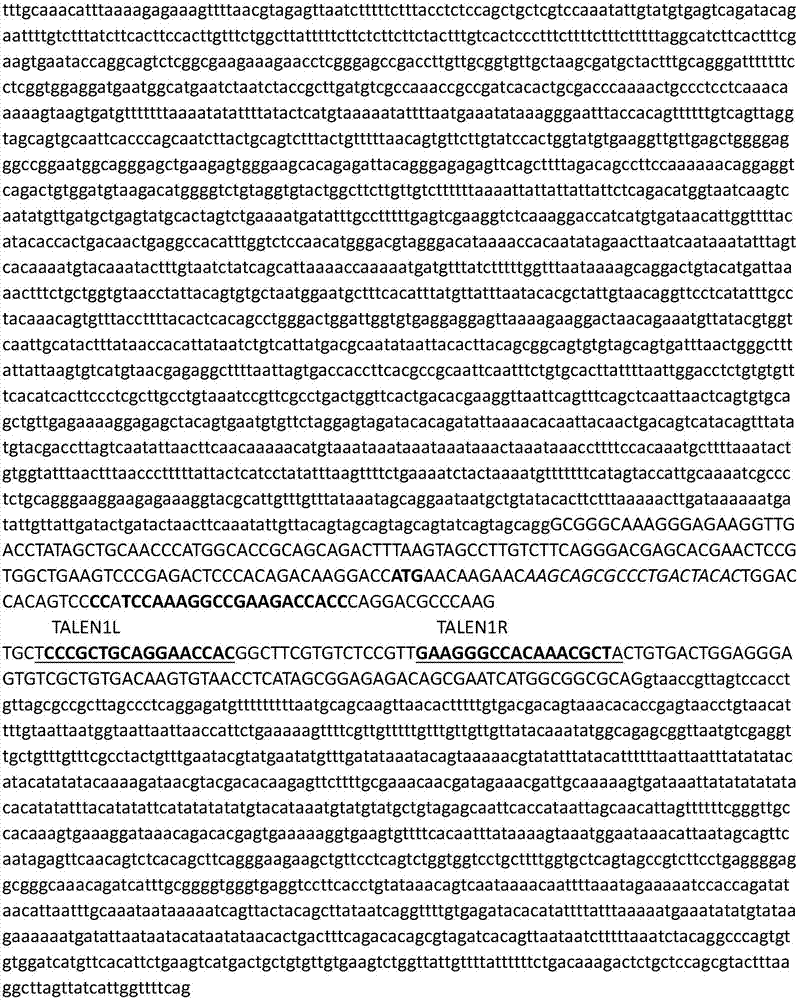A method and application of germplasm construction of marine flounder and flounder based on genome editing
A genome editing and construction method technology, applied in the field of marine fish genetics and breeding, can solve problems such as gonadal development, biological sex and fish size effects
- Summary
- Abstract
- Description
- Claims
- Application Information
AI Technical Summary
Problems solved by technology
Method used
Image
Examples
Embodiment 1
[0030] Example 1. Construction of TALEN plasmids for genome editing of Dmrt1 in half-smooth tongue sole:
[0031] 1. Construction method of genome editing TALEN plasmid:
[0032] According to the genome sequence SEQ ID NO: 1 of the half-smooth tongue sole Dmrt1 gene, a pair of TALEN binding sites were selected in the interval 80-140 nucleotides downstream of the start codon ATG in the coding region of exon 1, and the length of each binding site was 16-18bp nucleotides, the left and right binding sites are separated by 15-17bp, the sequence of the left binding site is 5'-CCCGCTGCAGGAACCAC-3'(SEQ ID NO:4); the sequence of the right binding site is 5'- AGCGTTTGTGGCCCTTC-3' (SEQ ID NO: 5); the upstream base of the starting base at the 5' end of the binding site sequence should be T.
[0033] The main steps of constructing the TALEN plasmid are as follows: first, according to the selected 17-base TALEN binding site sequence ( figure 1), using Addgene's kit TALEN Golden Gate toolk...
Embodiment 2
[0046] Example 2. In vitro transcription of genome editing plasmids:
[0047] The genome editing (TALEN) plasmid was transformed into Escherichia coli and cultured, and the genome editing plasmid was extracted using a plasmid extraction kit; the genome editing plasmid was digested with the corresponding restriction endonuclease NotI to make it linear; commercially sourced The in vitro transcription kit transcribes the linearized plasmid into the corresponding mRNA and purifies it.
[0048] The following takes the in vitro transcription of the Dmrt1 genome editing (TALEN) plasmid in half-smooth tongue sole as an example to describe in detail.
[0049] 1) The Dmrt1 TALEN plasmid required for in vitro transcription was obtained in two ways.
[0050] (1) Expansion culture of tongue sole Dmrt1 TALEN stored at -80℃
[0051] 1. Take out the strains stored at -80°C from the ultra-low temperature refrigerator, inoculate them into 100ml of LB medium after thawing, and incubate for 12 ...
Embodiment 3
[0078] Example 3, transfer of in vitro transcribed mRNA to fertilized eggs of marine flounder and flounder and culture of fertilized eggs
[0079] Adjust the concentration of the purified TALEN mRNA to 90-110ng / ul; collect the fertilized eggs of flounder and flounder with normal development at the 1-4 cell stage; transfer 100-300pg of TALEN mRNA into the animal pole of the fertilized eggs by conventional methods , then put the fertilized eggs into a beaker filled with sterile seawater at a constant temperature (22°C-23°C for half-smooth tongue sole, 14°C-16°C for flounder, and 12°C-13°C for turbot), And add 10000x 1% methylene blue solution (2ul per 100ml sterile seawater) into the beaker, and transfer the surviving fertilized eggs into new sterile seawater added with methylene blue every 3-5h. The cultivation method improves the hatching rate by 5%-10% compared with the traditional hatching pond flowing water culture.
[0080] The following takes the transfer of Dmrt1 TALEN ...
PUM
| Property | Measurement | Unit |
|---|---|---|
| weight | aaaaa | aaaaa |
| length | aaaaa | aaaaa |
| weight | aaaaa | aaaaa |
Abstract
Description
Claims
Application Information
 Login to View More
Login to View More - R&D
- Intellectual Property
- Life Sciences
- Materials
- Tech Scout
- Unparalleled Data Quality
- Higher Quality Content
- 60% Fewer Hallucinations
Browse by: Latest US Patents, China's latest patents, Technical Efficacy Thesaurus, Application Domain, Technology Topic, Popular Technical Reports.
© 2025 PatSnap. All rights reserved.Legal|Privacy policy|Modern Slavery Act Transparency Statement|Sitemap|About US| Contact US: help@patsnap.com



